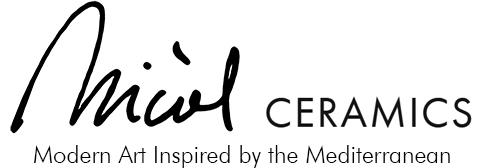I’ve been slowly crossing some of the items off my “to do “ list for this quarantine time. The next one up is to write a blog post about an amazing collaboration I worked on last year with Happy Menocal Studio.
My “Sitges” tableware collection has always been one of my favorites. It’s all hand-thrown on the potter's wheel from porcelain, with hand-carved edges that take a lot of time and care, but the result is so worth it! The collection, in clean white with undulating lines, is inspired by the elegant and relaxed beach lifestyle of coastal towns around where I grew up in Spain. The collection was customized for a wedding that took place in the Tuscan countryside, at Rosewood Castiglion del Bosco.
The wavy, Mediterranean-inspired dishware was stamped with a playful Happy Menocal monogram in four different colors, matching the tones of the hand-painted tablecloths, lampshades, and other items in the wedding that Happy designed.
The whole process was a labor of love! Each piece was thrown and dried, then the custom monogram was stamped into the surface, and the edges were carved with a knife. After these steps, the pieces were bisque-fired, glazed and hand-painted, then fired a final time.
The wedding project turned out so incredibly beautiful! The experience of this collaboration was very special for me, and I’m so grateful for the opportunity to work with the whole event team, including wedding planner Beth Helmsteter, photographer Stefano Santucci, flower designer Tuscany Flowers, and filmographer Alessandro Bordoni. And, of course, my lovely, extremely talented neighbor, Happy Menocal! It would be a dream to work with such talented people on all my future commissions!
Wedding photos courtesy of Stefano Santucci.
